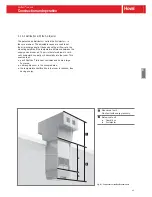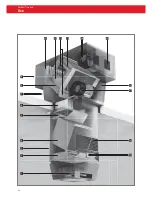
79
D
E
F
G
H
I
J
K
L
M
N
Checking the ancillary conditions
■
Maximum mounting height
The actual mounting height (= distance between the floor
and the bottom edge of the unit) must not exceed the
maximum mounting height H
max
(see Table D6).
■
Maximum floor area reached
Calculate the floor area reached per unit using the
selected number of units. If it exceeds the maximum
value listed in Table D4, increase the number of units.
■
Compliance with minimum and maximum distances
Check the resulting distances based on the space
requirements and arrangement of the units, using the
information in Table D7.
Actual mounting height
= 8.5 m
Max. mounting height H
max
= 9.5 m
→ OK
Floor area per unit
= 50 · 44 / 4 = 550 m²
Max. floor area reached
= 674 m²
→ OK
Minimum and maximum distances can be complied with
when units are arranged symmetrically.
→ OK
Definitive number of units
With a larger number of units, there is more flexibility of
operation. However, the costs are also higher. For an
optimal solution, compare both the costs and ventilation
quality of the system.
Select 4 TWH-9s. They guarantee cost-effective and
energy-saving operation.
RoofVent
®
twin heat
Design example
Summary of Contents for RoofVent CON-9
Page 2: ......
Page 4: ...2...
Page 6: ...4...
Page 8: ...6...
Page 12: ...10 RoofVent LHW Use...
Page 40: ...38 RoofVent LKW Use...
Page 68: ...66 RoofVent twin heat Use...
Page 94: ...92 RoofVent twin cool Use...
Page 122: ...120 RoofVent twin pump Use...
Page 150: ...148...
Page 154: ...152 RoofVent condens Use...
Page 180: ...210 RoofVent LH Construction and operation...
Page 208: ...238 RoofVent LK Use...
Page 256: ...286...
Page 268: ...298...
Page 274: ...304...
Page 279: ......










































